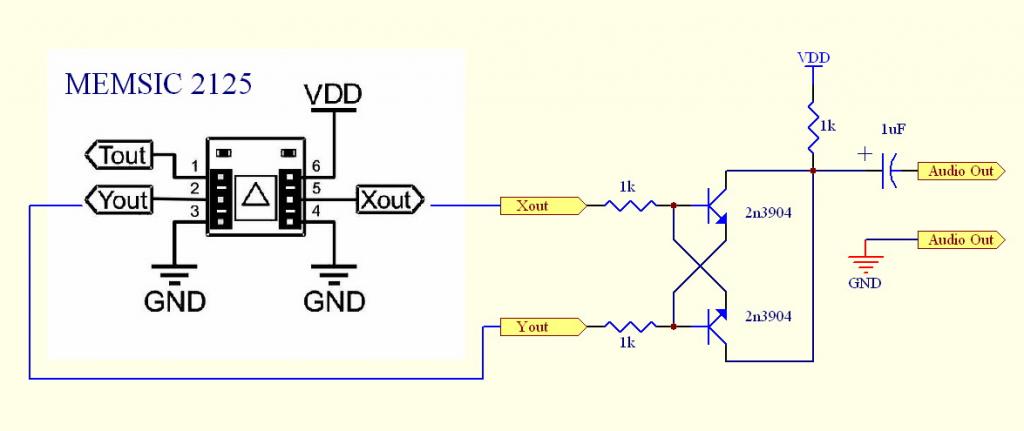Have you listened to your Memsic2125 ... Lately?
 Beau Schwabe
Posts: 6,575
Beau Schwabe
Posts: 6,575
Ok, so I was fiddling with a metal detector circuit to take up to Michigan later this month to see if I could comb the beach for some left over 4th of July pocket change people might have lost. ... Anyway, I came across a cool little add-on circuit that makes it real easy to hetero-dyne two signals as long as they are about 400mV apart from one another. Looking around to see what I have in the way of sensors that I could apply this circuit to I spot a Memsic 2125 .... Hmmm .... Only the output frequency is only 100Hz. That's OK, In the back of my mind, I remember Jeff Martin doing a scope experiment on the Memsic and discovered that the Start edges between X and Y happened at exactly the same time. This means we can "hetero-dyne" on the signal edge or ERROR between the X and Y.... assuming that at level the X and Y are identical. <-- and they are, we lucked out.
Schematic:

Here is a video of the result:
http://www.youtube.com/watch?v=8Q2PgoHpcIo
Schematic:

Here is a video of the result:
http://www.youtube.com/watch?v=8Q2PgoHpcIo


Comments
Very creative, but you're no closer to finding spare change on the beach. Or is there MORE to your story you haven't told us?
The metal detector is here:
http://www.youtube.com/watch?v=ZO8bU6KtEk4
The hetero-dyne circuit is the same for the metal detector as that used on the Memsic 2125 Demo. I won't be in Michigan for several weeks yet, but I have always had some luck at the public beach near the lighthouse in Frankfort, MI after the 4th of July (even a month after) Of course now that I've given the location I may be diminishing my findings ... The 4th of July is a huge beach event for this little town, ( it resembles Woodstock ) where everyone literally "digs in" and plants themselves in the sand to watch a night of fireworks out over the water. Needless to say, by "digging in" people tend to lose things. :-) that's where I like to come in.
Wouldn't the heterodyned Memsic output be silent if both axes were out of level by the same amount (i.e. rotating on a diagonal axis)? If you analog mix the outputs from two Memsics at right angles to each other, though, you'd have an out-of-level detector.
BTW, I think your circuit would make an execllent feedback mechanism for teaching coordinated turning to student pilots.
-Phil
+1 !!!!!!!!!
The Light to frequency converters would be fun to "hear" what happens when you hetero-dyne two of them together with the same circuit above, since the output is in the 40 to 60 kHz range. I don't have any or else I would try it.
I followed yer link and found http://www.ebay.com/itm/Quad-Inductor-Proximity-Metal-detector-US-seller-designer-/251234416967?pt=US_Metal_Detectors&hash=item3a7ebcf947
I asked Google what it was all about and Google came up empty.
Is there a forum thread for this
Thanks,
Rich
"...Is there a forum thread..." - No, this device was the result of Tuesday night local hacker space and my love for all things involving coils.
I can truly appreciate this comment, because I am also fond of relays, solenoids, and electromagnets, but "all things involving coils" is stretching it a bit for me.
Thank goodness for the invention of the cordless telephone..... As for the automotive high energy ignition coils, they may look user friendly, but don't be fooled by their looks
Light to Frequency Converter from Parallax:
http://www.parallax.com/StoreSearchResults/tabid/768/txtSearch/LIGHT/List/0/SortField/4/ProductID/784/Default.aspx
http://www.parallax.com/StoreSearchResults/tabid/768/txtSearch/LIGHT/List/0/SortField/4/ProductID/783/Default.aspx
Video Demo of the result:
http://www.youtube.com/watch?v=P4KaD_phbak